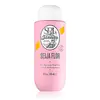What's inside
What's inside
 Key Ingredients
Key Ingredients

No key ingredients
 Benefits
Benefits

 Concerns
Concerns

 Ingredients Side-by-side
Ingredients Side-by-side

Water
Skin ConditioningSodium Cocoyl Isethionate
CleansingStearic Acid
CleansingSodium Methyl Cocoyl Taurate
CleansingGlycol Distearate
EmollientCocamidopropyl Hydroxysultaine
CleansingGlycerin
HumectantParfum
MaskingSqualane
EmollientCaryodendron Orinocense Seed Oil
EmollientHibiscus Sabdariffa Flower Extract
Skin ConditioningEthylhexylglycerin
Skin ConditioningTetrasodium Glutamate Diacetate
Polyquaternium-7
Sodium Isethionate
CleansingSodium Hydroxide
BufferingSodium Methyltaurate
Skin ConditioningXanthan Gum
EmulsifyingPhenoxyethanol
PreservativeWater, Sodium Cocoyl Isethionate, Stearic Acid, Sodium Methyl Cocoyl Taurate, Glycol Distearate, Cocamidopropyl Hydroxysultaine, Glycerin, Parfum, Squalane, Caryodendron Orinocense Seed Oil, Hibiscus Sabdariffa Flower Extract, Ethylhexylglycerin, Tetrasodium Glutamate Diacetate, Polyquaternium-7, Sodium Isethionate, Sodium Hydroxide, Sodium Methyltaurate, Xanthan Gum, Phenoxyethanol
Water
Skin ConditioningSodium Cocoyl Isethionate
CleansingCocamidopropyl Betaine
CleansingAcrylates Copolymer
Parfum
MaskingCoconut Acid
CleansingCocamide Mipa
EmulsifyingCocos Nucifera Oil
MaskingTheobroma Grandiflorum Seed Butter
Skin ConditioningHelianthus Annuus Seed Oil
EmollientEuterpe Oleracea Fruit Oil
Skin ConditioningTocopherol
AntioxidantCaprylyl Glycol
EmollientGlycerin
HumectantEthylhexylglycerin
Skin ConditioningGlycol Stearate
EmollientSodium Isethionate
CleansingGuar Hydroxypropyltrimonium Chloride
Skin ConditioningPhenoxyethanol
PreservativeSodium Chloride
MaskingCitric Acid
BufferingSodium Hydroxide
BufferingDisodium EDTA
Isopropanolamine
BufferingBenzyl Salicylate
PerfumingCoumarin
PerfumingHydroxycitronellal
PerfumingLimonene
PerfumingWater, Sodium Cocoyl Isethionate, Cocamidopropyl Betaine, Acrylates Copolymer, Parfum, Coconut Acid, Cocamide Mipa, Cocos Nucifera Oil, Theobroma Grandiflorum Seed Butter, Helianthus Annuus Seed Oil, Euterpe Oleracea Fruit Oil, Tocopherol, Caprylyl Glycol, Glycerin, Ethylhexylglycerin, Glycol Stearate, Sodium Isethionate, Guar Hydroxypropyltrimonium Chloride, Phenoxyethanol, Sodium Chloride, Citric Acid, Sodium Hydroxide, Disodium EDTA, Isopropanolamine, Benzyl Salicylate, Coumarin, Hydroxycitronellal, Limonene
 Reviews
Reviews

Ingredients Explained
These ingredients are found in both products.
Ingredients higher up in an ingredient list are typically present in a larger amount.
Ethylhexylglycerin (we can't pronounce this either) is commonly used as a preservative and skin softener. It is derived from glyceryl.
You might see Ethylhexylglycerin often paired with other preservatives such as phenoxyethanol. Ethylhexylglycerin has been found to increase the effectiveness of these other preservatives.
Glycerin is already naturally found in your skin. It helps moisturize and protect your skin.
A study from 2016 found glycerin to be more effective as a humectant than AHAs and hyaluronic acid.
As a humectant, it helps the skin stay hydrated by pulling moisture to your skin. The low molecular weight of glycerin allows it to pull moisture into the deeper layers of your skin.
Hydrated skin improves your skin barrier; Your skin barrier helps protect against irritants and bacteria.
Glycerin has also been found to have antimicrobial and antiviral properties. Due to these properties, glycerin is often used in wound and burn treatments.
In cosmetics, glycerin is usually derived from plants such as soybean or palm. However, it can also be sourced from animals, such as tallow or animal fat.
This ingredient is organic, colorless, odorless, and non-toxic.
Glycerin is the name for this ingredient in American English. British English uses Glycerol/Glycerine.
Learn more about GlycerinParfum is a catch-all term for an ingredient or more that is used to give a scent to products.
Also called "fragrance", this ingredient can be a blend of hundreds of chemicals or plant oils. This means every product with "fragrance" or "parfum" in the ingredients list is a different mixture.
For instance, Habanolide is a proprietary trade name for a specific aroma chemical. When used as a fragrance ingredient in cosmetics, most aroma chemicals fall under the broad labeling category of “FRAGRANCE” or “PARFUM” according to EU and US regulations.
The term 'parfum' or 'fragrance' is not regulated in many countries. In many cases, it is up to the brand to define this term.
For instance, many brands choose to label themselves as "fragrance-free" because they are not using synthetic fragrances. However, their products may still contain ingredients such as essential oils that are considered a fragrance by INCI standards.
One example is Calendula flower extract. Calendula is an essential oil that still imparts a scent or 'fragrance'.
Depending on the blend, the ingredients in the mixture can cause allergies and sensitivities on the skin. Some ingredients that are known EU allergens include linalool and citronellol.
Parfum can also be used to mask or cover an unpleasant scent.
The bottom line is: not all fragrances/parfum/ingredients are created equally. If you are worried about fragrances, we recommend taking a closer look at an ingredient. And of course, we always recommend speaking with a professional.
Learn more about ParfumPhenoxyethanol is a preservative that has germicide, antimicrobial, and aromatic properties. Studies show that phenoxyethanol can prevent microbial growth. By itself, it has a scent that is similar to that of a rose.
It's often used in formulations along with Caprylyl Glycol to preserve the shelf life of products.
Sodium cocoyl isethionate is a natural ingredient from coconut oil. It is an ultra gentle cleanser that gives a nice foam without drying the skin or impacting the skin barrier.
The amount of foam created depends on the amount of sodium cocoyl isethionate used in the product.
This ingredient also helps improve the spreadability of a product.
Learn more about Sodium Cocoyl IsethionateSodium Hydroxide is also known as lye or caustic soda. It is used to adjust the pH of products; many ingredients require a specific pH to be effective.
In small amounts, sodium hydroxide is considered safe to use. However, large amounts may cause chemical burns due to its high alkaline.
Your skin has a natural pH and acid mantle. This acid mantle helps prevent harmful bacteria from breaking through. The acid mantle also helps keep your skin hydrated.
"Alkaline" refers to a high pH level. A low pH level would be considered acidic.
Learn more about Sodium HydroxideWe don't have a description for Sodium Isethionate yet.
Water. It's the most common cosmetic ingredient of all. You'll usually see it at the top of ingredient lists, meaning that it makes up the largest part of the product.
So why is it so popular? Water most often acts as a solvent - this means that it helps dissolve other ingredients into the formulation.
You'll also recognize water as that liquid we all need to stay alive. If you see this, drink a glass of water. Stay hydrated!
Learn more about Water